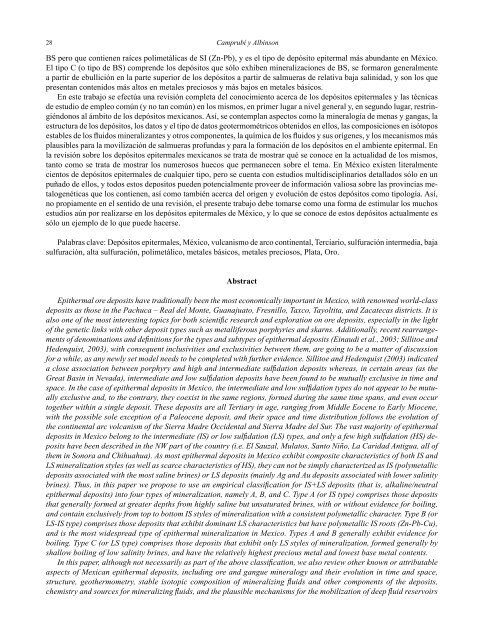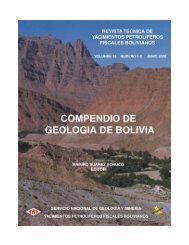Epitermales Mexico
You also want an ePaper? Increase the reach of your titles
YUMPU automatically turns print PDFs into web optimized ePapers that Google loves.
28<br />
Camprubí y Albinson<br />
BS pero que contienen raíces polimetálicas de SI (Zn-Pb), y es el tipo de depósito epitermal más abundante en México.<br />
El tipo C (o tipo de BS) comprende los depósitos que sólo exhiben mineralizaciones de BS, se formaron generalmente<br />
a partir de ebullición en la parte superior de los depósitos a partir de salmueras de relativa baja salinidad, y son los que<br />
presentan contenidos más altos en metales preciosos y más bajos en metales básicos.<br />
En este trabajo se efectúa una revisión completa del conocimiento acerca de los depósitos epitermales y las técnicas<br />
de estudio de empleo común (y no tan común) en los mismos, en primer lugar a nivel general y, en segundo lugar, restringiéndonos<br />
al ámbito de los depósitos mexicanos. Así, se contemplan aspectos como la mineralogía de menas y gangas, la<br />
estructura de los depósitos, los datos y el tipo de datos geotermométricos obtenidos en ellos, las composiciones en isótopos<br />
estables de los fluidos mineralizantes y otros componentes, la química de los fluidos y sus orígenes, y los mecanismos más<br />
plausibles para la movilización de salmueras profundas y para la formación de los depósitos en el ambiente epitermal. En<br />
la revisión sobre los depósitos epitermales mexicanos se trata de mostrar qué se conoce en la actualidad de los mismos,<br />
tanto como se trata de mostrar los numerosos huecos que permanecen sobre el tema. En México existen literalmente<br />
cientos de depósitos epitermales de cualquier tipo, pero se cuenta con estudios multidisciplinarios detallados sólo en un<br />
puñado de ellos, y todos estos depositos pueden potencialmente proveer de información valiosa sobre las provincias metalogenéticas<br />
que los contienen, así como también acerca del origen y evolución de estos depósitos como tipología. Así,<br />
no propiamente en el sentido de una revisión, el presente trabajo debe tomarse como una forma de estimular los muchos<br />
estudios aún por realizarse en los depósitos epitermales de México, y lo que se conoce de estos depósitos actualmente es<br />
sólo un ejemplo de lo que puede hacerse.<br />
Palabras clave: Depósitos epitermales, México, vulcanismo de arco continental, Terciario, sulfuración intermedia, baja<br />
sulfuración, alta sulfuración, polimetálico, metales básicos, metales preciosos, Plata, Oro.<br />
Abstract<br />
Epithermal ore deposits have traditionally been the most economically important in <strong>Mexico</strong>, with renowned world-class<br />
deposits as those in the Pachuca – Real del Monte, Guanajuato, Fresnillo, Taxco, Tayoltita, and Zacatecas districts. It is<br />
also one of the most interesting topics for both scientifi c research and exploration on ore deposits, especially in the light<br />
of the genetic links with other deposit types such as metalliferous porphyries and skarns. Additionally, recent rearrangements<br />
of denominations and defi nitions for the types and subtypes of epithermal deposits (Einaudi et al., 2003; Sillitoe and<br />
Hedenquist, 2003), with consequent inclusivities and exclusivities between them, are going to be a matter of discussion<br />
for a while, as any newly set model needs to be completed with further evidence. Sillitoe and Hedenquist (2003) indicated<br />
a close association between porphyry and high and intermediate sulfi dation deposits whereas, in certain areas (as the<br />
Great Basin in Nevada), intermediate and low sulfi dation deposits have been found to be mutually exclusive in time and<br />
space. In the case of epithermal deposits in <strong>Mexico</strong>, the intermediate and low sulfi dation types do not appear to be mutually<br />
exclusive and, to the contrary, they coexist in the same regions, formed during the same time spans, and even occur<br />
together within a single deposit. These deposits are all Tertiary in age, ranging from Middle Eocene to Early Miocene,<br />
with the possible sole exception of a Paleocene deposit, and their space and time distribution follows the evolution of<br />
the continental arc volcanism of the Sierra Madre Occidental and Sierra Madre del Sur. The vast majority of epithermal<br />
deposits in <strong>Mexico</strong> belong to the intermediate (IS) or low sulfi dation (LS) types, and only a few high sulfi dation (HS) deposits<br />
have been described in the NW part of the country (i.e. El Sauzal, Mulatos, Santo Niño, La Caridad Antigua, all of<br />
them in Sonora and Chihuahua). As most epithermal deposits in <strong>Mexico</strong> exhibit composite characteristics of both IS and<br />
LS mineralization styles (as well as scarce characteristics of HS), they can not be simply characterized as IS (polymetallic<br />
deposits associated with the most saline brines) or LS deposits (mainly Ag and Au deposits associated with lower salinity<br />
brines). Thus, in this paper we propose to use an empirical classifi cation for IS+LS deposits (that is, alkaline/neutral<br />
epithermal deposits) into four types of mineralization, namely A, B, and C. Type A (or IS type) comprises those deposits<br />
that generally formed at greater depths from highly saline but unsaturated brines, with or without evidence for boiling,<br />
and contain exclusively from top to bottom IS styles of mineralization with a consistent polymetallic character. Type B (or<br />
LS-IS type) comprises those deposits that exhibit dominant LS characteristics but have polymetallic IS roots (Zn-Pb-Cu),<br />
and is the most widespread type of epithermal mineralization in <strong>Mexico</strong>. Types A and B generally exhibit evidence for<br />
boiling. Type C (or LS type) comprises those deposits that exhibit only LS styles of mineralization, formed generally by<br />
shallow boiling of low salinity brines, and have the relatively highest precious metal and lowest base metal contents.<br />
In this paper, although not necessarily as part of the above classifi cation, we also review other known or attributable<br />
aspects of Mexican epithermal deposits, including ore and gangue mineralogy and their evolution in time and space,<br />
structure, geothermometry, stable isotopic composition of mineralizing fl uids and other components of the deposits,<br />
chemistry and sources for mineralizing fl uids, and the plausible mechanisms for the mobilization of deep fl uid reservoirs
















